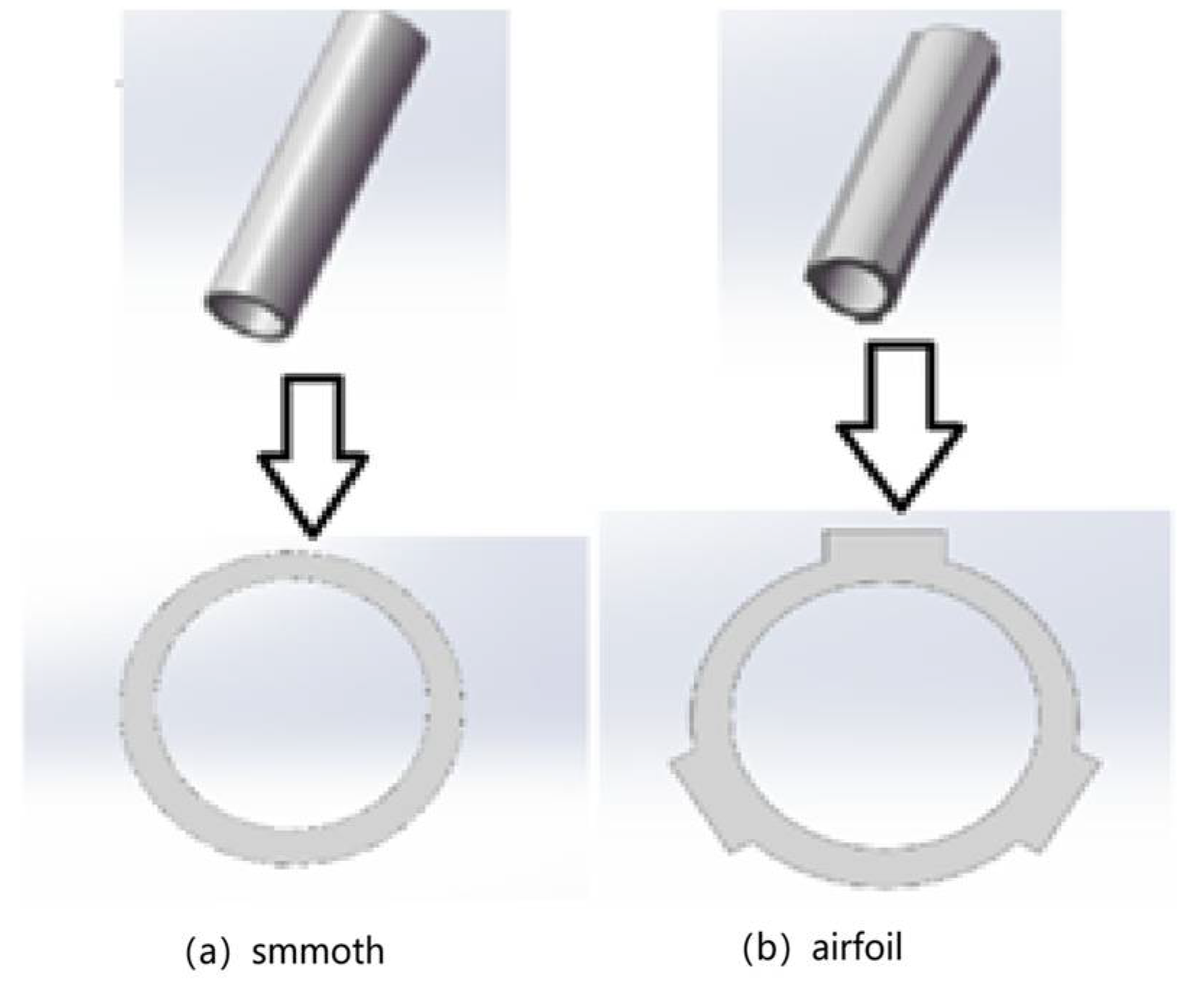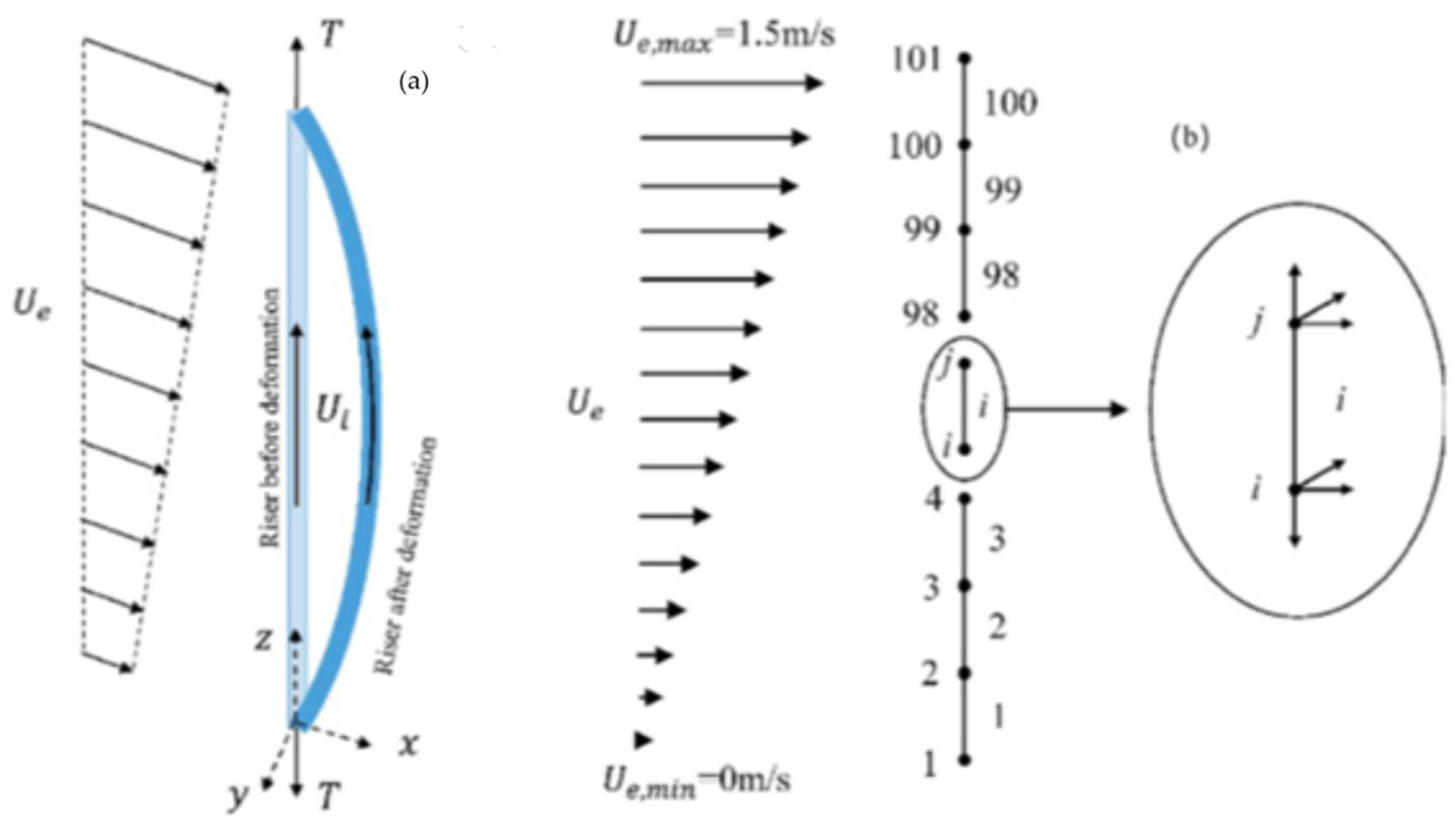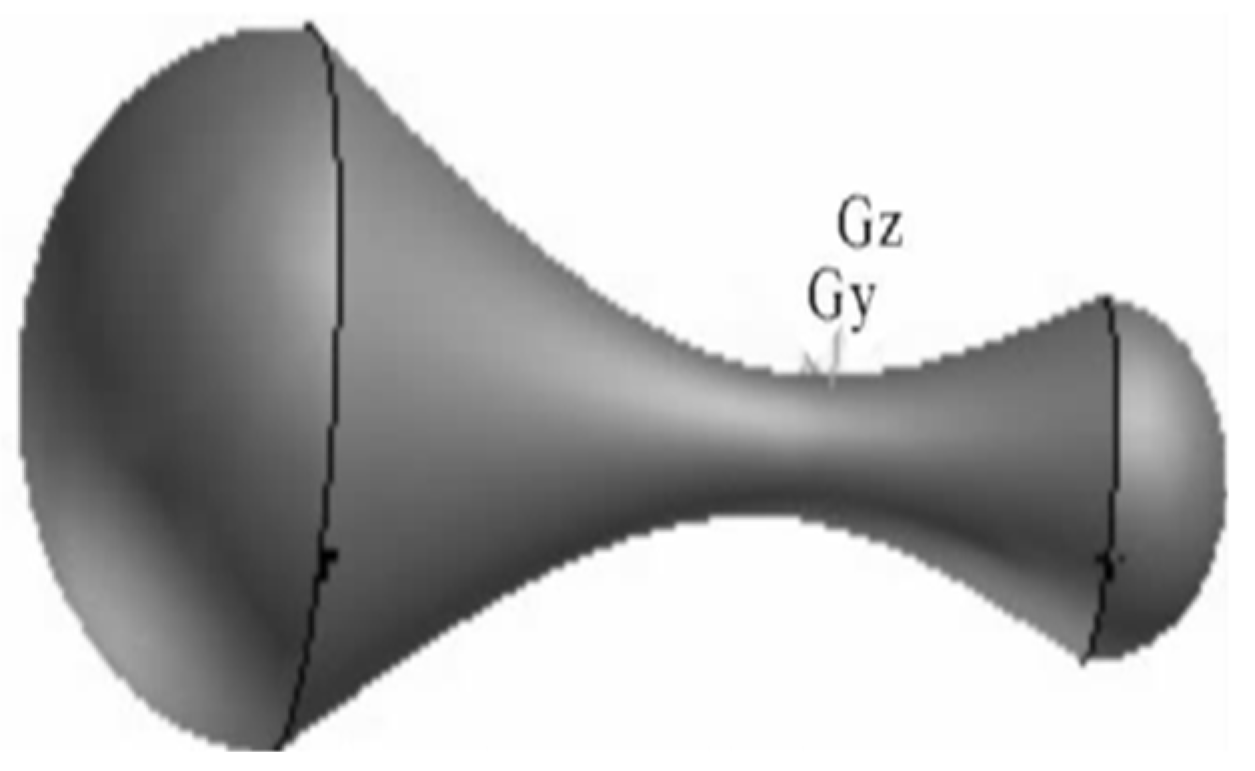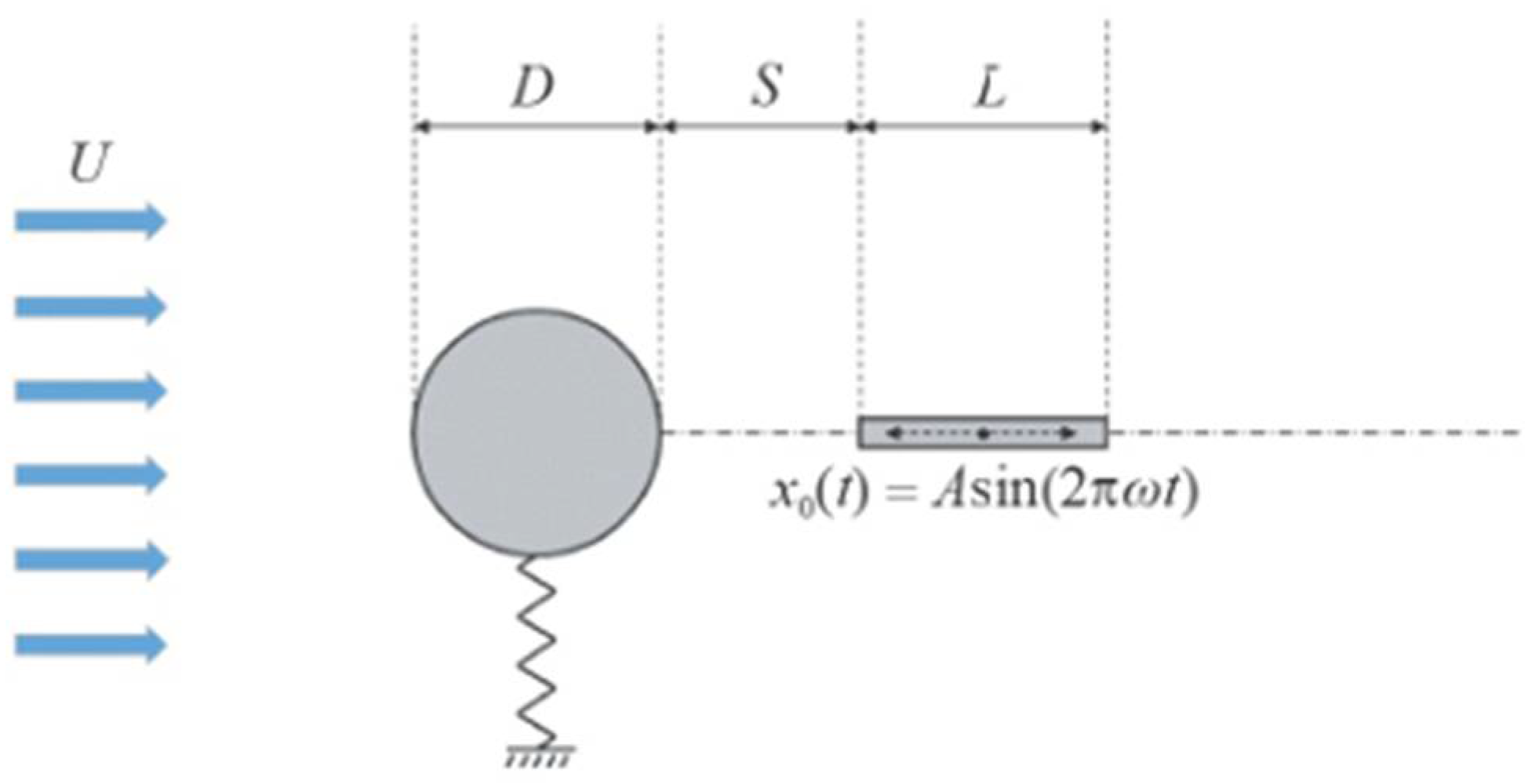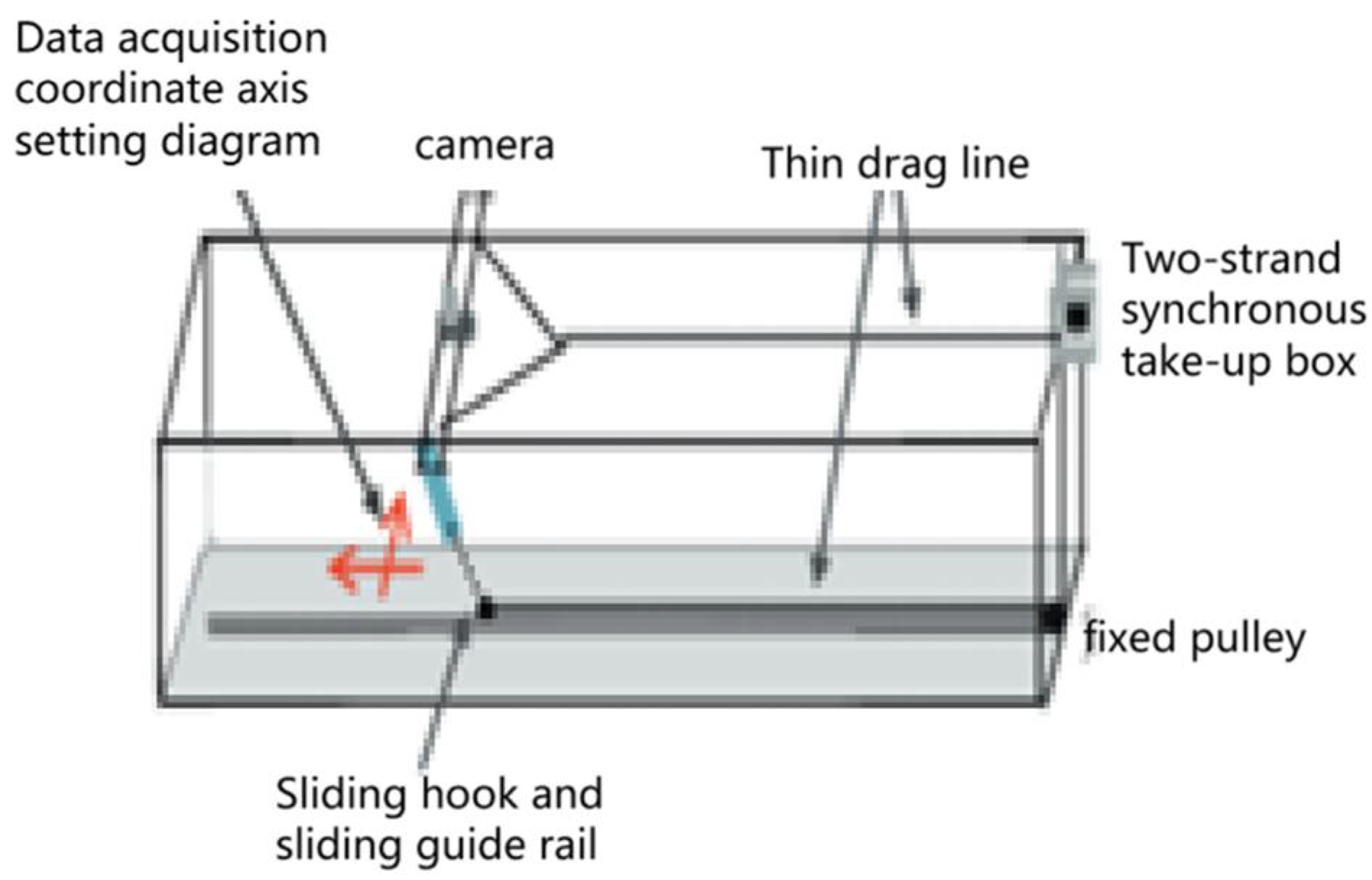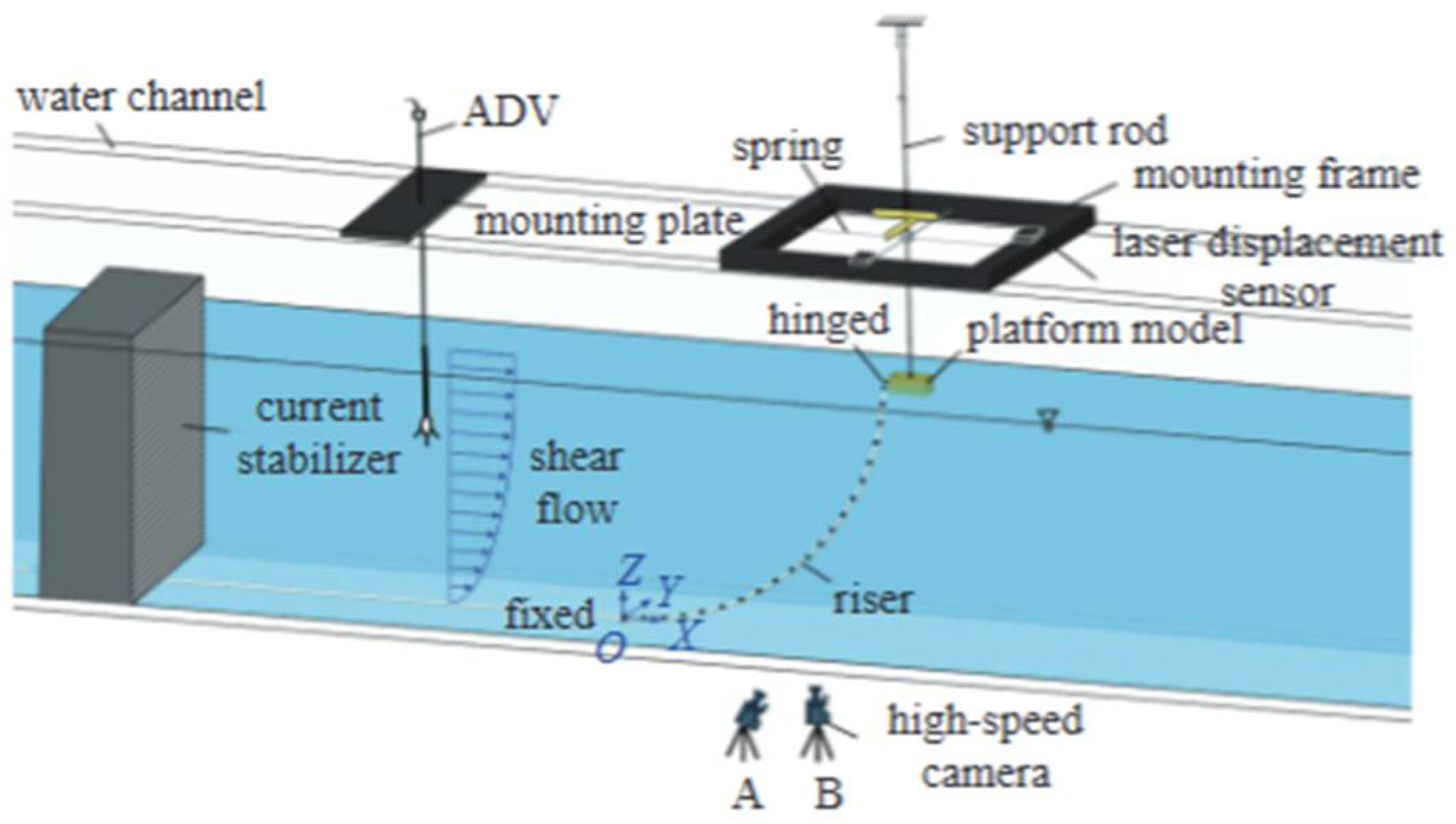1. Introduction
With the increasing global demand for energy, the exploration and development of offshore oil and gas resources are gradually advancing to deeper and more complex sea areas. In this process, a flexible riser system is the key lifeline to connect the subsea wellhead with the offshore production platform, and its safety and reliability are very important. These risers are usually slender flexible structures with a high aspect ratio for transporting oil and gas from the seabed to the floating platform. However, in deepwater environments, these structures are inevitably subjected to complex environmental loads, such as ocean currents, triggering a fluid–solid coupling phenomenon called vortex-induced vibration [
1].
VIV is caused by the coupling of periodic vortex shedding caused by fluid flow and the vibration of the riser structure. The fatigue damage of the riser is mainly caused by the vortex-induced vibration caused by the interaction between the external environment and the riser [
2,
3]. Therefore, in the field of marine engineering, a large number of studies on the influencing factors and suppression methods of the vortex-induced vibration of marine risers under complex sea conditions have been carried out, which has become a research hotspot in the field of marine engineering. When fluid flows through the bluff body structure at a certain flow rate, especially in the marine structure equipment, it is very common to use circular cross-section equipment. When the fluid flows through the circular structure equipment, it will produce a wake vortex that alternately falls off in the rear. The vortex street effect is explained as follows [
4]. When the fluid (such as water or air) flows through the flexible riser, the fluid forms a boundary layer on the surface of the riser due to the viscous effect. At the separation point, the vortex generated by the boundary layer separation swings to both sides with the lateral motion of the riser and overlaps and falls off in the near wake field. In the process of backward motion, the vortex pairs with opposite rotation directions fall off alternately, and the vortex energy continues to dissipate until the vortex breaks up and disappears, which is the formation process of Carmen vortex street. This shedding causes the fluid to exert alternating lift and drag on the structure, which leads to the periodic vibration of the riser [
5]. With the development of ultra-deepwater resources toward ultra-deepwater and long-span risers, the response mechanism of the VIV characteristics of flexible risers under complex conditions, such as non-uniform flow and multi-riser interference, needs to be further revealed. Vortex-induced vibration of flexible marine risers brings together difficult and important problems in the field of mechanics, such as turbulence, flow separation, the incomplete transition of the shear layer, and drift of separation point [
3]. And the high coupling between fluid motion and structural response increases the difficulty of solving this problem. So far, the academic community has not completely solved this problem.
The experimental study of vortex-induced vibration began in the middle of the 20th century. Feng [
6] first systematically tested a single-degree-of-freedom elastically supported cylinder in a wind tunnel. As the research advances, scholars [
7] gradually turned the experimental environment to the flume, focusing on the vibration characteristics of cylinders with a low mass ratio (m *) and low damping ratio (ξ), which are more in line with the actual working conditions of marine risers. In recent years, the team of Khalak [
8] and Govardhan [
9] improved the accuracy and reliability of the vortex-induced vibration experiment of the cylinder to a new level by improving the experimental device and measurement technology.
In terms of theoretical model development, the wake oscillator model proposed by Hartlen [
10] pioneered the theoretical study of vortex-induced vibration. The model has been successfully applied to the vibration analysis of flexible slender structures by Skop et al. [
11]. Guo [
12] further improved the theoretical model by introducing the influencing factors of internal flow. These theoretical works provide important analytical tools for understanding vortex-induced vibration.
Numerical simulation technology has made significant progress in recent years. The main methods include the discrete vortex method [
13], RANS, LES, and DNS [
14]. Among them, RANS and LES methods show good practicability in engineering applications. In terms of moving boundary processing technology, fixed grid methods, such as the virtual domain method and immersed boundary method, have become a hot research direction because of their computational efficiency advantages. The development of these numerical methods provides a new research method for the prediction of vortex-induced vibration under complex conditions.
Table 1 lists the advantages and disadvantages of the previous review of the vortex-induced vibration of flexible risers. At present, there are few reviews on the influence of the vortex-induced vibration of flexible risers and the direction of vortex-induced vibration suppression. In this paper, the latest progress and research on the vortex-induced vibration of flexible risers are summarized. The factors affecting vortex-induced vibration are analyzed from various angles, and how to suppress vortex-induced vibration is discussed systematically and in detail. Finally, the current technical bottleneck and future research trends are reasonably proposed, which complements the systematic research in the field of flexible risers and vortex-induced vibration.
3. Research on the Suppression of Vortex Vibration
3.1. Passive Vibration Suppression Technology
In the research field of suppressing vortex-induced vibration (VIV), passive vibration suppression technology is a classical strategy without an external energy input. The core idea is to directly interfere with the flow field around the structure by changing the geometric shape of the structure itself or installing auxiliary components, aiming to destroy the periodicity and regularity of vortex shedding. For example, adding spiral plates or pits on the surface of the cylinder can effectively disturb the flow and guide it to develop in three dimensions, thus disrupting synchronous vortex shedding along the axial direction of the structure and weakening the influence of the vortex excitation force from the source.
Another common type of passive vibration suppression method is to create an article in the wake region of the structure. By installing a separation plate or a fairing in the wake, the interaction between the shear layers on both sides can be effectively suppressed, or the structure can be streamlined, thereby reducing the flow separation, stabilizing the wake, and preventing the formation of alternating von Karman vortex streets. Because of their simple structure, economic reliability, and low maintenance cost, these passive technologies have been widely and successfully applied in engineering structures, such as marine risers, bridge cables, and high-rise chimneys.
Senga et al. [
32] studied the effects of spiral plate coverage and different pitches and screw heights on vibration suppression. Zhu et al. [
33] used the computational fluid dynamics (CFD) method to study the vortex-induced vibration of a circular cylinder with a freely rotating triangular fairing. Wang et al. [
34] proposed a scheme of installing rotating wings and analyzed the vortex-induced vibration characteristics of conventional marine risers and marine risers with rotating wings by the unsteady numerical calculation method. Wang achieved vibration suppression by controlling the surface roughness of the structure.
Ken et al. [
35] studied the influence of the number of screw heads on the suppression effect. When the number of screw heads increases to three, the increase in the number of screw heads had a limited effect on the suppression effect, but increased the average resistance. Gao et al. [
36] found that the height of the plate increased, the control frequency and the maximum displacement decreased, and the increase in the pitch delayed the production of the frequency locking zone. However, the range of the frequency locking region increased. Xu et al. [
37] further found that the suppression effect of the circular cross-section spiral plate on the vortex-induced vibration response frequency and the in-line displacement was slightly better than that of the square cross-section plate. Ma et al. [
38] experimentally studied the suppression effect of the spiral plate on the vortex-induced vibration of the riser under the action of time-varying axial force. Time-varying axial force excitation reduces the suppression efficiency of the spiral plate. Xu et al. [
39] studied the suppression effect of the spiral plate under the action of the angle of attack. As the angle of attack increases, the suppression efficiency of the spiral plate decreases significantly. There are usually auxiliary, small pipe cables around the riser. After good arrangement, it can interfere with the development of the boundary layer and play the role of a control rod.
Lu et al. [
40] studied the influence of the number of control rods and the installation angle on the suppression effect. When the installation angle of the four control rods was 45°, the suppression efficiency could reach 90%. Xu et al. [
41] experimentally observed the suppression effect of the control rod under the action of the angle of attack, and the suppression efficiency of the control rod on the vortex-induced vibration was less affected by the angle of attack.
According to the basic theory of fluid mechanics, Lou Min [
42] introduced a dog-bone device to suppress the vortex-induced vibration of marine risers, and the suppression effect of the device was tested by the ANSYS CFX 14.5 three-dimensional fluid–solid coupling method. The numerical simulation results show that the vibration suppression device not only effectively reduces the lateral vortex-induced vibration response, but also suppresses the longitudinal excitation, as shown in
Figure 3.
Ren Xiaohui [
43] mentioned that a turbine-type vibration-suppression D energy capture device dynamically changes the flow field distribution around the riser, disrupts the formation of the shear layer, and the vortex shedding form of the wake destroys the normal discharge of the vortex, thereby weakening the vortex shedding intensity and reducing the force of vortex shedding on the deep-sea riser. By converting wave energy into rotational motion, the device disrupts wake vortices and suppresses riser vibrations.
3.2. Active Control Technology
Unlike passive vibration suppression techniques that rely on fixed devices, the active technology for suppressing a vortex-induced vibration is an ‘intelligent’ control system that requires an external energy input. The core idea of this technology is to monitor the vibration state of the structure or the pressure distribution of the flow field in real time through sensors, and then transmit these signals to the controller for processing. The controller calculates the optimal control instruction according to the preset control algorithm (such as feedback control) and finally drives the actuator (actuator) to intervene in the flow field or structure to offset or weaken the vortex-induced force. Common active vibration suppression techniques include using piezoelectric materials or servo motors to directly apply a reverse force or displacement to the structure; a synthetic jet or plasma actuator is arranged on the surface of the structure, and the boundary layer characteristics are changed by periodic blowing and suction, which interferes with the stable formation and shedding of the vortex, or by controlling the rotation of the structure (such as a cylinder) to change its flow characteristics. Active control technology has strong adaptability and remarkable control effects. It is especially suitable for occasions with variable flow conditions or extremely high requirements for vibration suppression. It is the frontier research direction in the field of fluid–solid coupling.
Ren Feng [
44] constructed a closed-loop control loop with rotating excitation and wake velocity feedback as the core. Combined with the lattice Boltzmann method and the proximal strategy optimization algorithm, the amplitude of the cylinder was reduced by 89%. The proper orthogonal decomposition (POD) shows that intelligent control significantly changes the wake modal energy distribution.
Zou Lin [
45] added velocity feedback and displacement feedback to the theoretical model of vortex-induced vibration and explored the control law of velocity feedback and displacement feedback. At the same time, he introduced an intelligent algorithm, used a neural network to map the flow field information to the feedback gain, and used a genetic algorithm to optimize the parameters of a neural network, so as to obtain the optimal combination of velocity feedback and displacement feedback under different reduced flow rates. Therefore, an enhancement strategy of cylindrical vortex-induced vibration is proposed, and then the active control of cylindrical vortex-induced vibration under different flow rates is realized. The results indicate that velocity and displacement feedback add energy to the system. This extra energy excites the cylinder’s vibration and vortex shedding. Consequently, the vibration starts sooner with feedback than without control. The vibration frequency also increases. Thus, the cylinder’s vortex shedding frequency breaks away from its natural frequency. Finally, the vibration amplitude ratio of the cylinder is stabilized within the target amplitude ratio (0.6–0.8) in the reduced velocity range. This result shows that the external excitation can control the vibration speed and start-up time of the structure. At the same time, the feedback gain constraint is introduced into the intelligent control algorithm model, and the original calculation model is further optimized, so that the average energy consumption, J, is reduced by 33.08% compared with the unconstrained case, which greatly reduces the energy consumption of the active control process.
Ren [
46] numerically simulated the active control of the cylinder VIV and proposed a wave-oscillating splitter plate as a control device for the dynamic response of the cylinder. The displacement response, lift–drag coefficient, cylinder vibration frequency, energy efficiency, and flow field characteristics of the control strategy were analyzed extensively, and the physical mechanism of the control system was revealed. The results show that in most cases, except for high deceleration speed, the displacement response of the cylinder can be limited to a small range by the control device without feedback. In addition, the control strategy can be changed by feedback control to maintain a better control effect at a high reduction speed. The oscillating splitter plate delays the vortex shedding of the shear layer generated on the cylinder, and the wake vortex with opposite rotation is parallel to the flow direction, which reduces their lateral distance. Therefore, due to the change in the flow pattern caused by the oscillating splitter plate, the lift on the cylinder is greatly reduced. The schematic diagram of the flow model is shown in
Figure 4. In the diagram, a cylinder with a diameter of D = 0.01 m is immersed in a uniform flow at a flow rate of U, and the kinematic viscosity of the fluid is ν = 1 × 10 m
2/s. A rectangular plate with an edge length L (equal to the diameter of the cylinder, L = D) and a thickness ratio of 0.1 is placed at a distance S from the trailing edge of the cylinder. The plate is forced to perform simple harmonic vibrations in the flow direction. The equation of the simple harmonic vibration is as follows: where A is the vibration amplitude, t is the forced vibration frequency of the plate, and the angular frequency is defined as ω = 2πf.
Zhao Ming [
47] proposed that the passive flow control device includes a splitter plate, control rod, spiral plate, porous layer, and rough surface, and the active flow control device includes a jet, rotating cylinder, and rotating control rod. A certain length of the splitter plate can inhibit VIV, but a too-long splitter plate will cause galloping. One or two control rods located downstream of the flow separation point can suppress VIV. VIV suppression using three to eight control rods was also studied. Increasing the number of control rods can improve the suppression effect. The porous layer with sufficient porosity and thickness can achieve almost complete VIV suppression and usually has better a suppression effect than the rough surface. When the pitch ratio of the spiral plate is greater than 10 and the height is greater than 0.2 times the cylindrical diameter, the VIV can be well suppressed. If sufficient external energy is used, jet control and rotating control rods can achieve almost complete VIV suppression. Rotating the control rod in one direction can suppress VIV, but rotating it in the other direction can enhance VIV.
The variable-diameter cylinder technology proposed by Raafat [
48] realizes the dual-mode active control of vortex-induced vibration (VIV) by changing the outer diameter in real time through a built-in expansion pulley system, dynamically regulating the Reynolds number (Re) and the reduced flow velocity (Ur). The active tuning resonance in the energy harvesting mode expands the synchronization range by 70% and the power generation by more than 8 times. In the vibration suppression mode, the active detuning resonance weakens the vibration. This technology unified the energy collection and suppression function of VIV for the first time. The same system can intelligently switch modes according to the current conditions, collect energy for its self-power supply in the flat period, and suppress vibration and disaster prevention in the strong current period, which fundamentally solves the dual challenges of long-term energy supply and protection of underwater equipment.
Agathe [
49] Schmider’s key research in 2024 proposed a ‘virtual spring-damping system’. This electromechanical integration device uses a computer-controlled DC motor to apply a force proportional to the riser’s speed and displacement, thereby equivalently generating adjustable virtual stiffness and virtual damping. This allows the system to adjust its natural frequency in real time according to the changing flow field conditions to avoid the resonance frequency of VIV. This is a typical semi-active control strategy.
3.3. Physical Model Experimental Technology
3.3.1. Design of Experimental Device
In terms of multi-degree-of-freedom coupling experiments, Lei Yusheng [
50] adopted the following model experimental conditions: an empty d-center cylindrical buoy with a height of 10 cm and diameters of 2, 3, and 5 cm. The suspension line of the suspended cylindrical buoy was a soft nylon line with a length of 10 cm, and the uniform laminar flow (water, 20 °C) velocity range was from 5 cm/s to 25 cm/s. In addition, the range of Reynolds number Re (1.8 × 10
3–8.1 × 10
4) was obtained from the range of water flow velocity (drag velocity) and cylinder diameter used in the experiment. It can be seen that the experimental environment is basically in a typical subcritical state. The experimental scenario of vortex-induced motion is the motion of the bottom-hanging buoy under the uniform laminar impact environment. According to the basic principles of fluid mechanics, this uniform laminar flow state was difficult to obtain directly. Referring to the previous experimental experience and the principle of relative motion, the towing tank design was adopted. Compared with previous large-scale experiments, the uniqueness of this experiment is its small scale, low cost, and obvious results. The towing tank design and synchronous camera design used in this experiment have their own advantages compared with domestic large-scale devices. The device consisted of two parts: (1) Experimental environment device: coverless, transparent, glass box; bottom sliding guide rail; and pulley hook. The function of this part is to make the pulley, the hook, and the hollow cylindrical buoy hanging on it slide uniformly from one side of the water injection box to the other side with a fixed trajectory under the traction of the tractor. In this way, the scenario of uniform laminar flow impacting the bottom-mounted buoy was simulated equivalently. (2) Double constant-speed tractor and synchronous photography device: the main role is data acquisition. A micro-high-definition camera was fixed on the sliding frame and was towed at a constant speed by another towing line and the hook on the guide rail (an experimental cylindrical buoy was hung on the hook). At this time, the storage camera recorded the image directly below the synchronous sliding frame, thus realizing synchronous photography. Lei Yusheng’s specific experimental device diagram is shown in
Figure 5.
Based on the self-circulation experimental flume, Zhu Hongjun [
51] carried out a vortex-induced vibration response test of a catenary flexible riser with platform surge and sway motion. The length–diameter ratio of the model riser was 125, and the average reduced velocity range of the test was 4.40–39.33. A laser displacement sensor and high-speed camera were used to monitor the platform motion and riser vibration displacement, respectively, and the influence of platform motion on the vibration of the riser was analyzed from the aspects of response frequency, amplitude, and vibration form. The experiment was carried out in the self-circulation experimental flume of Southwest Petroleum University. The flume test section was 2 m (length) × 0.5 m (width) × 1 m (height), and the experimental water depth was 0.65 m. A generalized model was used in the experiment. The transparent silicone tube with an outer diameter of D = 8 mm (wall thickness 1 mm) was selected as the flexible riser model, and the length–diameter ratio L/D = 125 was arranged in the flume test section in a catenary shape. The bottom was fixed to the bottom wall of the flume, the top was hinged at the bottom of the platform, and the riser was concave. The vertical height was h = 0.65 m. The riser was completely immersed in water, and the lateral blocking rate was 1.6%, which met the critical blocking rate requirement of less than 5%. The experimental tank is shown in
Figure 6.
3.3.2. Measurement and Visualization Techniques
The measurement and visualization technology of the vortex-induced vibration of flexible risers is the core method to study the dynamic response of risers in deep-sea engineering. The technology realizes real-time monitoring and full-field visualization of the strain, displacement, and wake vortex structure of the riser in the complex flow field by means of a fiber grating sensor, digital image correlation (DIC) technology, and high-speed camera. The experiment usually simulates the deep-sea environment in the flume and studies its multi-modal response characteristics under vortex-induced vibration by adjusting the flow velocity, flow field distribution (such as uniform flow, shear flow), and riser parameters (slenderness ratio, pre-tension). Combined with numerical simulation and experimental data, this technology can reveal the fatigue damage mechanism of risers and provide key support for deep-sea pipeline designs and safety assessments.
Lyons et al.’s [
52] measurement technology (on-site monitoring-FUMS system) used a novel curvature-sensing element to measure the bending stress of submarine umbilical cables. A load sensor was installed at the top of the umbilical cable to measure the tension. Data analysis: The new method was used to identify the contribution of different frequency components (mooring system, wave, and vortex-induced vibration) to excitation, and the rain-flow counting method was used to evaluate fatigue life. Main contributions: High-quality VIV data from real operating environments are provided, revealing the increase in the drag coefficient caused by VIV, and providing insights into the contribution of different excitation sources to fatigue damage.
According to Chaplin et al. [
53], an experimental study was conducted on a top-tensioned aluminum-core riser model (covered with a fluorine-containing plastic tube) to measure its VIV response under stepped flow and different tension conditions, and to identify vibration modes. Such experiments use strain gauges or accelerometers. Experimental data of the VIV response of flexible risers under specific conditions are provided, which are often used to compare other numerical models or experimental results.
This study was proposed by Seyed-Aghazadeh [
54] to investigate the flow-induced vibration (FIV) characteristics of flexible cylinders with triangular cross-sections at different angles of attack and reduced velocities (0.9–16.27, corresponding to Reynolds number 364–3600) through water tunnel experiments, including transverse, in-line, and torsional vibrations. The three-dimensional vibration (cross flow, downstream flow, and torsion) of the flexible triangular cylinder is recorded by motion tracking technology. Although the details of the specific camera and marker system are not detailed in the abstract, this study highlights the significant effects of torsional oscillation, spanwise flexibility, and fixed boundary conditions on the response. Hydrogen-bubble flow visualization technique was used to qualitatively observe the wake field of the cylinder to preliminarily understand the shape and shedding mode of the vortex.
Gao et al.’s research [
55] aims to experimentally explore the influence of gas–liquid two-phase slug flow on the vibration response of a catenary flexible riser. The core requirement is to synchronously and non-invasively capture the vibration displacement details of the riser and the flow pattern characteristics of the slug flow inside the pipeline (such as liquid slug length and pressure pulsation) and to study the effects of two key flow parameters, gas–liquid mixing speed and gas–liquid ratio, on the vibration response of the flexible riser. A high-speed camera system is used to capture synchronous, non-invasive visualizations of the vibration displacement of the riser and the characteristics of internal slug flow (such as liquid slug length and aeroelastic shape).
4. Challenges and Prospective Studies
As the global energy demand extends to the deep sea, the structural safety and integrity of marine risers, such as the key ‘lifeline’ connecting the subsea wellhead and the floating platform, are facing unprecedented challenges. VIV is a typical nonlinear fluid–solid coupling phenomenon. Its complex physical mechanism and potentially destructive consequences make it a long-term research hotspot and a difficult design in the field of marine engineering.
4.1. Challenges
4.1.1. The Uncertainty of the Predicted Dilemma Model
Despite decades of in-depth research, the accurate and reliable prediction of riser VIV is still one of the most challenging tasks in marine engineering. The inherent limitations of the prediction model and the scale difference between the experimental data and the real working conditions together constitute an insurmountable ‘prediction dilemma’. This uncertainty directly leads to conservatism in engineering design and triggers a series of interlocking economic and technical problems.
Table 2 below compares the different models.
4.1.2. Inhibition Technology: From Passive Intervention to Active Control
The passive system permanently interferes with the vortex-shedding process by changing the geometric shape or hydrodynamic characteristics of the riser. The active/semi-active system uses intelligent materials and control algorithms to sense and offset vibrations in real time. The evolution of technology clearly shows the trend from ‘violent intervention’ to ‘smart control’.
- (1)
Passive suppression system: trade-off between efficiency and cost
Increasing the fin height can significantly enhance the vibration suppression effect, while changing the pitch will affect the range of the ‘lock-in’ zone. Under the optimized design, the vibration suppression efficiency can reach more than 90%. However, the greatest disadvantage of a helical strake is its large size.
Fairings provide another efficient solution. Different from the ‘destruction’ mechanism of the plate, the guide cover adopts the ‘dredging’ strategy. Its streamlined shell can guide water flow smoothly around the riser, fundamentally avoiding the formation and shedding of strong vortices. The shroud is designed to rotate freely around the riser so that its tail can automatically align with the incoming flow direction and always maintain the best streamlined shape. The vibration suppression effect of the diversion cover is excellent and is considered to be ‘unparalleled’. Its biggest advantage is that it not only does not increase the drag force but can be significant.
- (2)
Active and semi-active control: application of smart materials
Active control: The system uses an external power supply to apply a control force that is opposite to the vibration velocity or displacement through an actuator (such as a piezoelectric plate), thereby actively offsetting or suppressing vibration. This method has strong adaptability and a good effect, but the system is complex, energy consumption is high, and the cost is high.
Semi-active/passive shunt damping: This is a potential compromise. It connects the piezoelectric plate to an external electronic ‘shunt’ circuit (such as a simple RLC circuit). When the structure vibrates, the electric energy generated by the piezoelectric sheet will be dissipated in the shunt circuit (usually in the form of heat energy), thus equivalently providing adjustable additional damping to the structure. This method does not require a large external power supply and has the simplicity of a passive system and the tunability of an active system.
At present, the application of active and semi-active control technology in the field of the VIV suppression of risers is still mainly in the laboratory research stage. To promote it to engineering applications, many challenges need to be overcome, including the development of robust control algorithms for complex fluid–solid coupling problems, ensuring the long-term reliability of the system in harsh marine environments, and how to scale up the application of technology to large marine structures.
Early helical strakes permanently disrupt flow to suppress vibration but always create high drag. The hood passively adapts to flow conditions, cooperating rather than conflicting with the flow. Future active/semi-active systems will deliver intelligent vibration control. They no longer permanently transform the structure, but precisely apply the control force when and where it is needed. The core objective of energy regenerative damping is to maximize energy recovery efficiency. It transforms the problem itself (vibration energy) into a part of the solution (control system power supply), indicating the high intelligence and high efficiency of VIV suppression technology in the future. Behind this evolution is the high cost and secondary problems of traditional methods, as well as the continuous maturity of enabling technologies, such as intelligent materials and control theory.
4.2. Prospect
In the face of the continuous challenges of VIV prediction and suppression, the marine engineering community is ushering in a profound paradigm change. The future development direction is no longer limited to the improvement of a single prediction model or vibration suppression device, but rather to a lifecycle ‘intelligent riser integrity management’ framework that integrates advanced sensing, artificial intelligence, and system modeling. The core of this transformation is to move from a static and conservative design concept to a dynamic and intelligent operation and management model, replacing the conservatism based on assumptions and experience with real-time and data-driven insights, which is expected to greatly optimize operational efficiency and lifecycle costs while ensuring or even improving safety.
This paradigm shift from a ‘static design’ to ‘dynamic management’ highlights the direction for future research. Firstly, it is necessary to develop a hybrid prediction model that can integrate the speed of semi-empirical methods, the accuracy of CFD, and the learning ability of AI to perform fast and accurate engineering decisions. Secondly, we should continue to promote the development of advanced suppression technologies, including new low-resistance passive devices and active/semi-active control systems based on smart materials from laboratory to application. At the same time, in order to ensure the reliable application of AI in safety-critical systems, it is very important to establish a standardized verification and certification process for AI models. Finally, it is necessary to deepen the research on the mechanism of multi-physical field coupling effects, such as VIV and platform motion, internal multiphase flow, and seabed interaction, so as to lay a foundation for higher-level prediction and control.
5. Conclusions
The vortex-induced vibration (VIV) of flexible risers in ocean engineering is a comprehensive subject involving complex physical mechanisms, diverse engineering practices, and frontier scientific exploration. As a core issue directly related to the structural integrity and service life of risers, the in-depth understanding, accurate prediction, and effective suppression of VIVs are always the key links to ensure the safety of deep-sea energy development. Although the industry has accumulated rich experience in suppression technology and prediction models, there are still profound challenges and broad exploration space in this field. The main conclusions and prospects of this paper are summarized as follows:
(1) Complex coupling of influencing factors: Vortex-induced vibration (VIV) of flexible risers is a complex fluid–solid coupling phenomenon driven by multiple factors. Its response characteristics not only depend on the structural parameters of the riser itself (such as slenderness ratio, mass ratio, top tension, damping, surface roughness, etc.), but also are significantly affected by external flow field conditions (such as incoming flow velocity, velocity profile, wave action, etc.) and possible platform motion coupling effects. These factors work together to create complex dynamic behaviors, such as multi-modal excitation, broadband characteristics, and the coexistence of traveling waves and standing waves in riser VIV responses, which makes the accurate prediction and comprehensive understanding of VIV extremely challenging.
(2) Diversity and trade-off of suppression strategies: For the vortex-induced vibration of flexible risers, the current engineering field mainly relies on passive suppression devices. While spiral plates are widely used due to their reliable vibration suppression effect, they increase structural drag force as a relative drawback. Other additional accessories, such as deflectors/fairings, separation plates, and new spiral grooves, as well as design-level strategies, such as optimizing riser configurations (such as inert wave risers) and adjusting top tension, have also been adopted to reduce VIV. Due to its complexity and the reliability challenges of underwater applications, the active control method is rarely used in practical engineering. The selection of the suppression strategy should take into account the effect of vibration suppression, economic cost, convenience of installation and maintenance, and the impact on other hydrodynamic factors (such as additional resistance).
(3) Cross-driven research bottlenecks and prospects: the VIV research on flexible risers still faces many bottlenecks, including the accurate prediction of VIV responses under high Reynolds number and complex flow fields (such as shear flow), the lack of full-scale experimental data, and the extrapolation of experimental results to practical engineering, as well as the limitations and computational costs of existing numerical models (whether semi-empirical models or CFD) in capturing three-dimensional effects and fluid–solid coupling complexity. Future research trends will focus more on the development of high-fidelity numerical simulation methods (such as improved CFD technology and finer fluid–solid coupling algorithms), more refined experimental measurements (such as advanced flow field display technology and distributed sensing technology), and full-scale in-service monitoring, as well as the integration of advanced data analysis tools, such as artificial intelligence and machine learning, for pattern recognition and surrogate model construction, to reveal the VIV mechanism more deeply, improve prediction accuracy, and develop more efficient and economical suppression techniques.
In summary, vortex-induced vibration is a core and complex challenge in the field of fluid–solid coupling. Its effective suppression is the cornerstone to ensure the safety and reliability of various engineering structures, especially key equipment, such as marine flexible risers, throughout their lifecycle. From general passive control devices, such as helical strakes and shrouds, to system configuration optimization for flexible risers (such as lazy waveform designs), an effective suppression strategy system has been developed in the engineering community. The core of these methods is to destroy the regularity of vortex shedding by changing the hydrodynamic shape or system dynamics characteristics of the structure, so as to avoid its potential destructive force. Practice has proved that there is no universal ‘best’ solution. The choice of vortex vibration suppression strategy is a comprehensive decision that is highly dependent on engineering experience. It requires designers to conduct a comprehensive and prudent assessment of structural characteristics, environmental conditions, economic costs, and safety risks. Looking forward to the future, as the project moves toward addressing a deeper and harsher environment, the continuous optimization and innovation of vortex-induced vibration suppression technology will still be an indispensable part of ensuring project safety.
